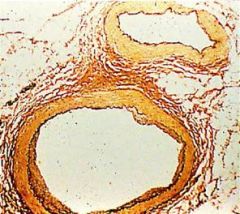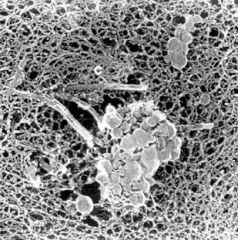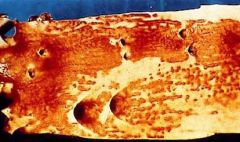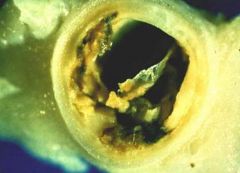![]()
![]()
![]()
Use LEFT and RIGHT arrow keys to navigate between flashcards;
Use UP and DOWN arrow keys to flip the card;
H to show hint;
A reads text to speech;
28 Cards in this Set
- Front
- Back
|
Describe the first stage of atherosclerosis
|
-Asymptomatic
-Takes years to develo -Involves build up of atherosclerotic plaques in the arteriole wall -Plaque made from fat cells and extracellular material -Worst it can cause is exertional angina -As plaque builds up there is outward remodeling to preserve the lumen -Body can make new collateral vessels via neovasculatization |
|
|
Describe the second stage of atherosclerosis
|
-Acute thrombus formation in the lumen
-Starve distal tissue of oxygen and nutrients leading to tissue death and dysfunction -This can lead to unstable angina |
|
|
Which lipoproteins trigger atherosclerosis?
|
-The ones that have apo-B,
-LDL and chylomicron remnants are the most atherogenic |
|
|
What is a good biomarker for overall risk of atherosclerosis?
|
LDL
|
|
|
Describe the stages of atherosclerosis that occurs in the preteen years
|
-If lipoproteins stay in the vasculatrure for long enough they can get stuck in the subendothelial space in certain areas of the arterial tree.
-In places with flow disturbances (such as branching points) there are proteoglycans to cushion the flow -Later in life the apoB lipoproteins stick to these proteoglycans -In the preteen years you start to retain LPs |
|

|
Unoccluded coronary artery
|
|

|
Occluded coronary artery
|
|

|
Subendothelial lipoprotein aggregation and matrix retention
|
|
|
Describe the phase of atherosclerosis that occurs in a persons teenage years
|
-Retained LPs undergo modification, such as oxydation
-They start to look like bacteria -Antibodies start to recognize the LPs -Macrophages are called in |
|
|
Describe the phase of atherosclerosis that occurs when a person reaches their 20s
|
-Monocytes come in and eat the retained lipoproteins
-They try to metabolize the fats -The cholesterol becomes stored inside the macrophages and they develop a foamy appearance -Bioactive components trigger the macrophages |
|
|
Describe the phase of atherosclerosis that occurs in a persons 20s and beyond
|
-Part of the maladaptive response involves continual recruitment of inflammatory cells
-There is no clean up phase -There is continuous recruitment of inflammatory cells -Dead cells that are not cleaned up leads to necrosis -This can lead to breakage/eruption of the plaque which exposes thrombogenic material |
|
|
What causitive evidence is there to support the response to retention model of atherosclerosis
|
-When there are no ApoB lipoprotiens there is no maladaptive inflammatory response and no atherosclerosis
-When there is decreased retention there is decreased atherosclerosis -LP retention occurs before the earliest phase of atherogenesis |
|
|
What is the root cause of atherosclerosis?
|
ApoB
|
|
|
Describe the reversibility of plaque formation leading to atherosclerosis
|
As the inflammatory response gets going, new proteoglycans get made that are stickier than the first ones and other molecules are made that further aid retention. Retention becomes amplified as the lesion gets going. There is reversibility but regression is a lot harder towards the end compared to the beginning.
|
|
|
Describe the lesions that are most susceptible to rupture
|
-Not neccessarilly the biggest
-Most susceptible are the ones with the most necrosis and the thinnest scar -Normally the scar is protective, but if it thins out then the plaque is more likely to rupture |
|
|
Describe the necrotic core
|
-"Graveyard for dead macrophages"
-These are the macrophages that come in as part of the inflammatory response -They die but don't get eaten -They become necrotic -This necrotic core triggers inflammation, provides material that can trigger thrombosis, is filled with proteases and can put a stress on the fibrous cap. |
|
|
What causes the necrotic core to form?
|
Failure to clear the dead macrophages
|
|
|
Describe the relationship between smooth muscle cells and scar formation
|
-There are smooth muscle cells that make the scar.
-When those smooth muscle cells start to die the scar formation tones down. -As the scar gets eaten away by some of the proteases in the necrotic core the smooth muscle cells are not robust enough to make new scar. |
|

|
-Fatty streak
-Focal accumulation of cholesterol |
|

|
-Foam cells
-Cellular component of the fatty streak -Macrophages have eaten the lipids and are in the subendothelial space |
|

|
Plaque rupture
|
|
|
Describe the treatment of atherosclerosis
|
-The only successful treatment is getting rid of the root cause
-Statins lower LDL and decrease cardiac disease |
|
|
What two things are needed for atherosclerosis?
|
-"High" levels of apoB-lipoproteins in the bloodstream
-A "susceptible" arterial wall (i.e., susceptible to apoB-LP retention or responses to retention) |
|
|
What are some risk factors for arterial wall susceptibility?
|
-Family history
-Low HDL -Smoking -Diabetes -Age -?CRP Future: Gene chips |
|
|
What therapeutic approach should be used to prevent and reverse atherosclerosis?
|
Decrease the probability of ApoB-LP entry and then retention in the subendothelium
|
|
|
Why might a patient who smokes and has high LDL not get atherosclerosis?
|
Genes are incredibly important
|
|
|
Describe the treatment for atherosclerosis
|
Therapeutic Lifestyle Change (TLC):
Improve Diet Weight Reduction Physical Activity Pharmacologic Treatment: Statins (HMG-CoA reductase inhibitors) Fibrates Niacin Bile acid sequestrants Cholesterol absorption inhibitors |
|
|
Describe the phrase "earlier is better"
|
-Atherosclerosis begins at an early age
-The early stages are more easily reversible -The less ApoB you have the better |

